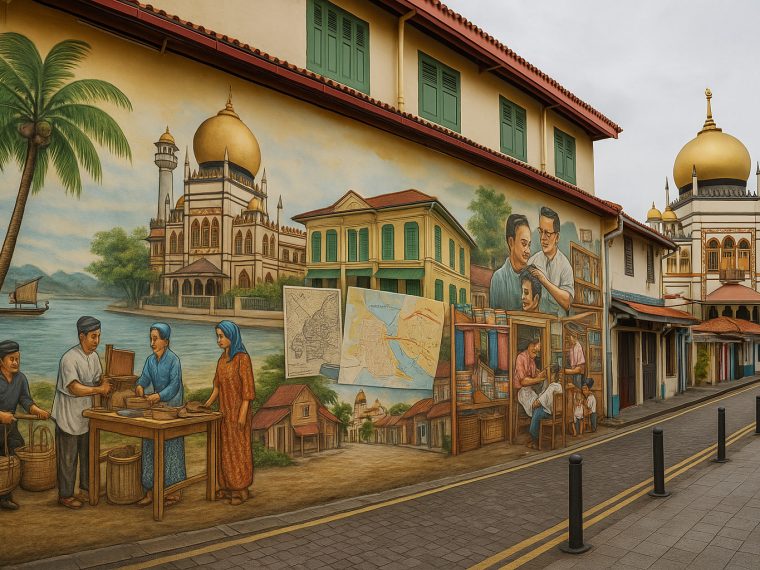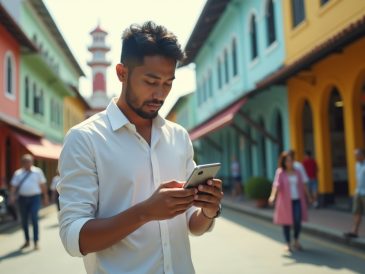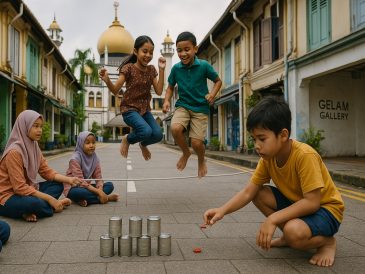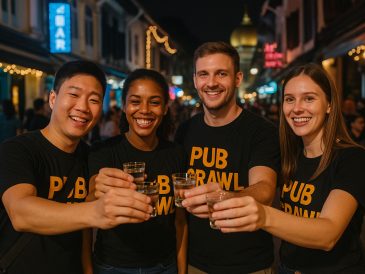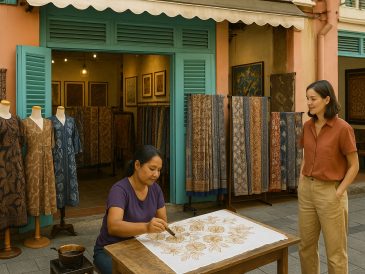Kampong Gelam stands as one of Singapore’s most vivid cultural enclaves. Beyond its bustling eateries, textile shops, and historical architecture, it offers an ever-changing canvas for street art. The wall murals here do more than decorate—they narrate, reflect, and reimagine the past and present. They transform the district into a living museum where tradition and modern artistry intersect at every turn.
Why Kampong Gelam?
The district’s roots as Singapore’s Arab/Muslim quarter lend a deep historical backdrop. Murals scattered across shophouse walls, alleyways, and even construction barriers blend storytelling with visual vibrancy. From commissioned pieces by renowned artists to grassroots graffiti, every mural contributes to a collective identity shaped by culture, migration, trade, and artistic energy.
Notable Streets and Murals to Experience
1. Haji Lane
Haji Lane stands as the unofficial poster child of Kampong Gelam street art. Bright colors and bold lines stretch across narrow façades. Local businesses such as Piedra Negra commission artists to produce eye-catching exteriors. Among the most photographed is the Aztec-themed mural by Didier ‘Jaba’ Mathieu, a piece that fuses cultural myth with urban style.
2. Muscat Street – Gelam Gallery
Tucked behind Muscat Street is Singapore’s first outdoor gallery: Gelam Gallery. Since 2019, its back alleys have showcased over 30 works by both local and international artists. The artworks span from elaborate murals to intricate mosaics, with plaques offering descriptions similar to those found in indoor galleries. Some of the most striking pieces are contributed by artists from Oman, creating a cross-cultural dialogue in color and form.
3. Arab Street
Arab Street is home to some of the district’s most narrative-rich murals. Artist Yip Yew Chong has created pieces here that are rooted in memory and history. One of his prominent works, painted in August 2023, sits at 92 Arab Street. It depicts Kampong Gelam’s transformation—from a seafront village to a cultural node—featuring scenes of daily life, trades, and landmarks like the Sultan Mosque and Istana Kampong Gelam. The mural includes interactive elements and map comparisons to engage visitors.
4. Jalan Pinang
Hotel NuVe commissioned Yip Yew Chong in 2016 for murals that speak to Kampong Gelam’s food and botanical legacy. “Satay Club” revives Singapore’s street food history, while “Kampong Gelam” nods to the Gelam trees that gave the area its name. These pieces offer nostalgia layered with cultural detail, quietly honoring the ordinary lives of past residents.
5. Aliwal Arts Centre
A hotbed for local urban art, the walls of Aliwal Arts Centre are in constant conversation with emerging styles. During the annual Aliwal Urban Arts Festival, artists refresh this space with new visuals. “AlphaBatik” by Slacsatu is a standout—merging Batik patterns with graffiti techniques to create a pulsating display of heritage and flair.
6. Graffiti Hall of Fame
Along Ophir Road and Bali Lane, what began as a functional necessity—metal noise barriers for construction—has turned into a linear gallery. This stretch, nearly 240 meters long and 5 meters high, features murals by 17 Singapore-based artists. Each piece includes a QR code, guiding viewers to a microsite with artist bios and artwork details. Collaborative works and standalone pieces form a unified mosaic of the city’s street art talent.
Themes Woven into the Walls
Heritage and History
Yip Yew Chong’s works often transport viewers to the past. Scenes of barbers, provision shops, and children at play capture memories fading from the physical landscape. These murals act as visual time capsules, keeping stories alive as buildings and demographics change.
Cultural Fusion
Artists throughout the district draw from Malay, Chinese, Arab, and Western influences. From Batik-inspired graffiti to Aztec motifs, the wall art mirrors Kampong Gelam’s plural identity. It’s not forced multiculturalism—it’s a portrait of real coexistence made visible through shape and shade.
Community and Identity
The public nature of these murals reinforces belonging. Local initiatives like Gelam Gallery and Graffiti Hall of Fame create accessible platforms for artists while reclaiming public space for creative expression. Art is not confined to frames or museums; it lines everyday paths, inviting reflection and response.
Urban Adaptation
The reuse of construction barriers for public murals shows how infrastructure can carry visual and cultural value. Instead of blocking views, these structures now offer them. This approach reshapes how people interact with construction sites—not as eyesores, but as temporary chapters in the district’s story.
Key Projects and Initiatives
- Gelam Gallery (2019)
Transformed a nondescript alley into a curated outdoor gallery. Artists were given creative freedom, resulting in an eclectic showcase that still feels cohesive. - Graffiti Hall of Fame (2021)
Turned metal barriers into statement walls. Beyond beautification, the project supports local talent and shifts perceptions of street art’s role in public spaces. - Aliwal Urban Arts Festival (Annual)
Hosts live painting sessions, music, and exhibitions. It’s a pulse check for Singapore’s street art scene, allowing murals to stay fresh and relevant. - Urban Redevelopment Authority & Kampong Gelam Alliance
These groups continue to support art in the precinct. Their efforts go beyond murals, with ongoing plans for new installations and site-specific artworks to maintain the area’s cultural vibrancy.
What Makes Kampong Gelam’s Street Art Distinct
- Artist-Led Storytelling: Many works are not abstract splashes of color but thought-out narratives about place, time, and community.
- Open-Air Accessibility: Unlike traditional galleries, every wall is open, free, and integrated into daily movement.
- Evolving Canvas: Frequent refreshes, new commissions, and festivals ensure the district never stands still.
- Interactive Features: QR codes and descriptive plaques help passersby connect with the artists and their intent.
Final Thought
Kampong Gelam’s murals are not backdrops for social media—they are chapters in an unfolding story. They speak of migration, food, faith, change, and resilience. Every brushstroke on a back alley or a noise barrier adds to the layered identity of a district that continues to honor its roots while looking forward. Through walls once blank or bare, Kampong Gelam narrates itself—publicly, proudly, and in full color.
